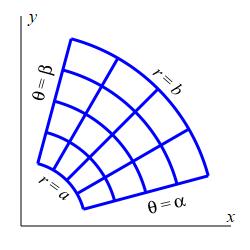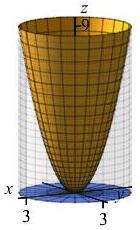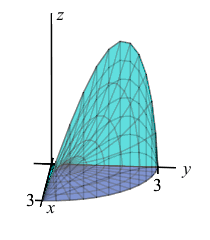21. Multiple Integrals in Curvilinear Coordinates
a. Integrating in Polar Coordinates
2. Integral over a Polar Rectangle
Recall the Riemann sum definition of a double integral, and its formulation for a rectangle in rectangular coordinates. We now formulate it for a polar rectangle in polar coordinates.
If \(R\) is the polar rectangle \([a,b]\times[\alpha,\beta]\), then
\[\begin{aligned}
\iint\limits_R f(x,y)\,dA
&=\int_\alpha^\beta\int_a^b f(r,\theta)\,r\,dr\,d\theta \\
&=\int_a^b\int_\alpha^\beta f(r,\theta)\,r\,d\theta\,dr
\end{aligned}\]
In particular, for a polar rectangle, the iterated integral with constant
limits is independent of the order of integration.

(1) These are just the iterated integrals computed by holding the outer variable
fixed while doing the inner integral and then completing the outer integral.
(2) In these formulas, the important thing to remember is that the differential
of area is
\[
dA=r\,dr\,d\theta
\]
and \(r\) becomes part of the integrand when we compute the \(r\) integral.
(3) If we reverse the order of the differentials, we must also reverse
the limits on the integrals.
Find the volume under the piece of the paraboloid \(z=x^2+y^2\) above the circle \(x^2+y^2 \le 9\).

The volume is the double integral: \[ V=\iint\limits_R (x^2+y^2)\,dA \] To compute it, we write \(dA\) and \(x\) and \(y\) in polar coordinates: \[ dA=r\,dr\,d\theta \qquad x=r\cos\theta \qquad y=r\sin\theta \] So the volume may be computed as the iterated integral: \[\begin{aligned} V&=\int_0^{2\pi}\int_0^3 (x^2+y^2)\,r\,dr\,d\theta =\int_0^{2\pi}\int_0^3 r^3\,dr\,d\theta \\ &=\int_0^{2\pi} 1\,d\theta\int_0^3 r^3\,dr =2\pi\left[\dfrac{r^4}{4}\right]_0^3 =\dfrac{81\pi}{2} \end{aligned}\]
In rectangular coordinates, this would be: \[ V=\int_{-3}^3\int_{-\sqrt{9-x^2}}^{\sqrt{9-x^2}} (x^2+y^2)\,dy\,dx \] which would be much harder to compute.
Find the volume under the hyperboloid \(z=xy\) above the quarter circle \(x^2+y^2 \le 9\) in the first quadrant.

\(\displaystyle V=\int_0^{\pi/2}\int_0^3 r^3\sin\theta\cos\theta\,dr\,d\theta =\dfrac{81}{8}\)
The quarter circle in the first quadrant satisfies \(0 \le \theta \le \dfrac{\pi}{2}\). So the volume is: \[\begin{aligned} V&=\int_0^{\pi/2}\int_0^3 (xy)\,r\,dr\,d\theta =\int_0^{\pi/2}\int_0^3 r^3\sin\theta\cos\theta\,dr\,d\theta \\ &=\int_0^3 r^3\,dr\int_0^{\pi/2} \sin\theta\cos\theta\,\,d\theta =\left[\dfrac{r^4}{4}\right]_0^3\left[\dfrac{\sin^2\theta}{2}\right]_0^{\pi/2} \\ &=\dfrac{81}{4}\left(\dfrac{1}{2}\right)=\dfrac{81}{8} \end{aligned}\]
Heading
Placeholder text: Lorem ipsum Lorem ipsum Lorem ipsum Lorem ipsum Lorem ipsum Lorem ipsum Lorem ipsum Lorem ipsum Lorem ipsum Lorem ipsum Lorem ipsum Lorem ipsum Lorem ipsum Lorem ipsum Lorem ipsum Lorem ipsum Lorem ipsum Lorem ipsum Lorem ipsum Lorem ipsum Lorem ipsum Lorem ipsum Lorem ipsum Lorem ipsum Lorem ipsum